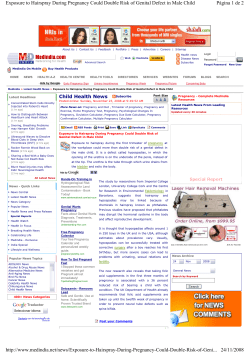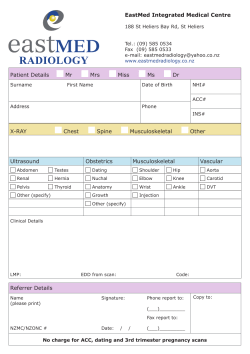
• and after exercise. Drink small amounts of fluid frequently.
www.thepregnancycentre.com Fact sheet Pregnancy and exercise There is no doubt about it – pregnancy is physically demanding! Regular exercise is an essential way of helping your body cope with the increased demands on your joints, muscles, heart, circulation, and lungs. and after exercise. Drink small amounts of fluid frequently. Avoid exercise in the heat of the day. • Watch your heart rate Keep your heart rate under 150 bpm. Exercise at your own comfort level. • Wear a bra Benefits of exercise in pregnancy • Regular exercise can help reduce back pain, improve or maintain muscle tone, reduce leg cramps, swelling and constipation and improve sleep patterns. Women who exercise regularly often feel better about themselves and their changing body during pregnancy. • Women who exercise are less likely to experience fatigue due to improved sleep, reduced anxiety, reduced pain perception, reduced neuromuscular tension (has a tranquillizer effect) and improved fitness. Do’s and don’ts of pregnancy exercise Every pregnant woman must take special precautions and considerations with exercise during pregnancy. Some essential guidelines are listed below to help you with a safe exercise program during your pregnancy. • Do consult your doctor, specialist or midwife When starting a new exercise program, or continuing with your current exercise program in pregnancy, it is important to consult with your doctor, obstetrician, or medical specialist and/or midwife. If you have any specific problems, or discomforts, you should make sure you discuss these to determine if you need to take any special precautions. The type and amount of exercise that you normally do and have done recently will influence the advice that your doctor or midwife provides when giving you advice regarding exercise during pregnancy. • Do not overheat Avoid exercise on extremely hot or humid days. Position yourself near the air conditioner or fan for aerobics classes. Do not use the solarium, spa, steam room or overheated pools. Keep fluid intake up before, during Always wear a good supportive bra while exercising. Check your bathing costume for support also if you are doing water aerobics. You may wish to wear a bra under your costume. • Do not exercise for long on your back Do not spend a long time exercising while lying on your back. Choose exercises/stretches that are done while seated or upright. It is not recommended that you exercise lying on your back from 16–18 weeks of pregnancy or after the first trimester. There are some exercises that can be modified and performed on your side as an alternative. • Be aware of the effects of relaxin This hormone softens your joints, which may increase the risk of injury during pregnancy. Take care when stretching and avoid contact sports after the first trimester, or on advice of your medical practitioner. Always brace your abdominal muscles when lifting and maintain good posture. • Eat carbohydrates before exercise Blood sugar levels can fluctuate rapidly during pregnancy. Always eat food containing carbohydrates 1–2 hours before exercising. Carry juice with you to drink if you feel faint or dizzy. If this occurs, slow down or stop exercising. • Do pelvic floor exercises Pelvic floor muscle exercises are essential. You must exercise your pelvic floor muscles before, during and after pregnancy. • Do bracing exercises Stomach curls and crunches should cease as soon as you are pregnant and pregnancy abdominal bracing exercises should be done on a regular basis. To learn Reproduced with kind permission from The Pregnancy Centre™ • For further information visit www.thepregnancycentre.com Contact the National Continence Helpline on 1800 33 00 66 or www.continence.org.au © Continence Foundation of Australia–The Pregnancy Centre 2008 page of 3 Fact sheet Pregnancy and exercise about pregnancy abdominal bracing refer to the fact sheet Pregnancy and post natal abdominal muscle bracing. • Monitor your rectus diastasis This is the ‘gap’ that occurs between your abdominal muscles during pregnancy. You can decrease the width of this gap by using correct posture and ceasing abdominal curls and crunches. It is wise to keep a regular check on the width of this gap. If you are unsure of how to do this, your midwife or physiotherapist can check this gap for you. • Watch your posture Always maintain correct form and posture during exercise. Brace your abdominal muscles and be aware of your back at all times. To maintain good posture when standing, lift yourself up tall, stand with your abdominal muscles braced, your shoulders back and gently nod your chin in. Try to maintain this position regularly during the day. Ideal exercises during pregnancy (if no complications) • Walking • Low impact aerobics • Water aerobics • Pregnancy exercise classes • Cycling • Swimming • Light weight training (see your instructor for assistance with your program) Exercises to avoid during pregnancy • Heavy weights • Bouncing – especially star jumps, or similar activities • Contact sports • Excessive breaststroke at the end of your pregnancy, as this puts stress on your pelvis • Any activities or exercises which cause pain • Excessive twisting and turning activities • Exercises that require you to hold your breath • Asymmetrical weight bearing activities (ie. those involving standing on one leg for a period of time as these can place excessive strain on your pelvis) • Pushing off with one leg at a time when swimming – try to push off with both feet when you turn at the end of the pool • Prolonged standing static exercises • Highly choreographed exercises or those which involve sudden changes in direction • Lifting your hip up to the side (hip abduction) while kneeling on your hands and knees • Activities involving sudden changes in intensity • Exercises which increase the curve in your lower back (your lumbar spine) • Prolonged bouncing as this can overstretch the pelvic floor muscles More tips for pregnancy exercise • NOTHING should hurt! Exercise should make you feel good, gently increase your fitness and be fun. If any exercise causes pain, stop it immediately or advise the instructor if you are in a class. • Take care not to overheat as your body’s response may be to divert blood flow from your baby and reduce the fetal heart rate. You should not exercise in high temperatures or high humidity. Choose a cooler time of the day to exercise. Always take a water bottle with you when you exercise, even in a pool – dehydration can still occur in water even though you don’t notice it as much. • Exercise in a heated pool can sometimes cause a drop in blood pressure. If you feel dizzy, or short of breath, take a break on the steps and place your head down towards your knees. For the same reason, you may want to sit for about five minutes before you race off after a class or swimming. • Have a rest during exercise if you feel you need one. Remember to work at your own pace and do not compete if you are in a class situation. You should be able to comfortably talk while you are exercising, to ensure that you are not working too hard. Do not push through pain or fatigue. • It is important to take more time to warm up and cool down when you are pregnant, to prepare your body for exercise and to prevent blood pooling in your legs or leg cramps. Reproduced with kind permission from The Pregnancy Centre™ • For further information visit www.thepregnancycentre.com Contact the National Continence Helpline on 1800 33 00 66 or www.continence.org.au © Continence Foundation of Australia–The Pregnancy Centre 2008 page of 3 Fact sheet Pregnancy and exercise • Avoid suddenly stopping while exercising as this can cause low blood pressure, lightheadedness or fainting. If you need to stop exercising, keep your feet moving to help the blood flow back to the heart. For information about exercising after the birth, see the fact sheet Returning to sport or exercise after the birth. • Do not exercise if you are unwell or extremely fatigued. • Remember that pain or shortness of breath should not be felt at any time. STOP exercising and seek advice if you experience any of the following: – Dizziness, faintness, headaches, blurred vision, nausea or vomiting – Any kind of pain or numbness – Discomfort or excess fatigue after you have exercised – Vaginal bleeding, contractions, leaking of amniotic fluid, or reduced movements of your baby The benefits of water exercise during pregnancy • Body weight is supported during exercise. This places less stress on joints and ligaments than exercising on land, so there is less chance of joint injury. • The weight of the uterus is supported, so women experience less abdominal heaviness when exercising in water, especially in the last few months of pregnancy. • No detrimental effects known. Women can exercise right up to their due date, providing that medical check ups permit. • The pressure of the water helps to improve venous blood flow, and this can help to reduce swelling in the lower limbs. • Exercising in water can be relaxing and relieve pain. • Can experience less muscle soreness than after exercising on land. Reproduced with kind permission from The Pregnancy Centre™ • For further information visit www.thepregnancycentre.com Contact the National Continence Helpline on 1800 33 00 66 or www.continence.org.au © Continence Foundation of Australia–The Pregnancy Centre 2008 page of 3
© Copyright 2025




















